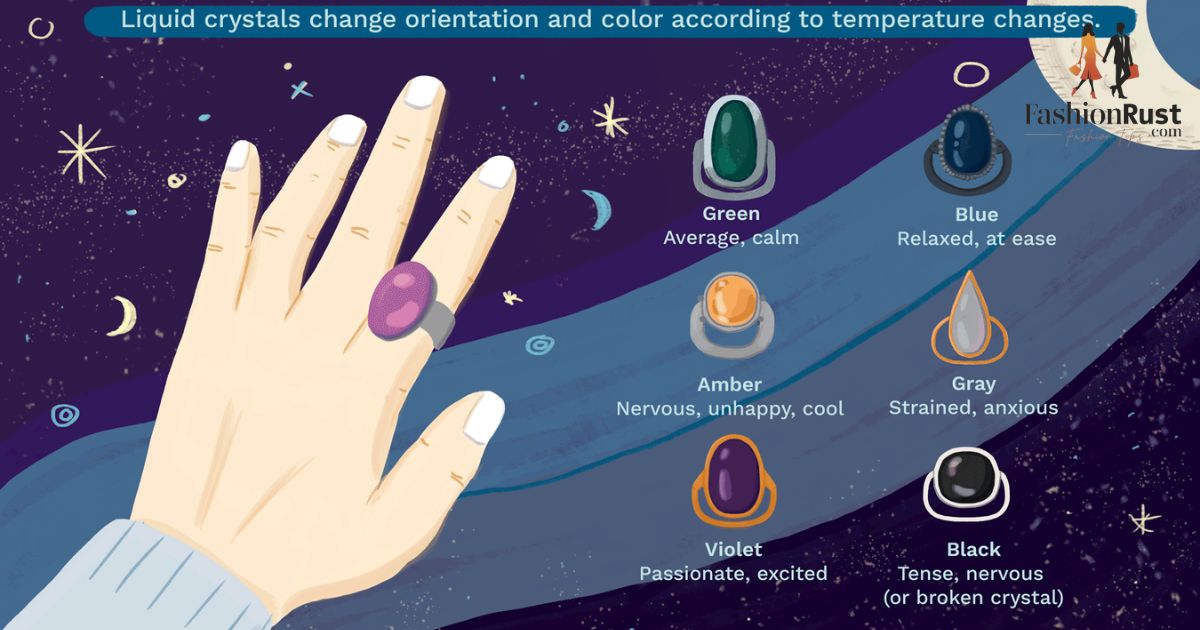“Mood ring colors” are various colors exhibited by mood rings when there is a shift in body temperature. They are thought to symbolize different feelings based on each color, even though some people argue that they do not really show how someone feels.
Mood ring colors are believed to represent different emotions based on body temperature. However, their accuracy in reflecting true feelings is debated. Some say they provide insight into mood changes, while others question their reliability. Exploring mood ring colors can be a fun way to ponder emotions, but don’t rely on them for precise interpretations.
History of the Mood Rings
The mood ring concept first appeared in 1975 when Josh Reynolds and Maris Ambats came up with it. Even though Marvin Wernick opposes that point, claiming he made them before, Reynolds and Ambats are generally seen as the real creators.
In the seventies of the last century, these rings caught people’s imagination, symbolizing a period during which everyone wanted to express themselves in different ways.
Mood rings, originally popularized during the hippie movement, were characterized by colorful and mysterious forms that reflected the mood of the time.
Although their popularity diminished thereafter, they continued to represent a past era as well as provoke memories of feeling old-fashioned combined with wonder about how style meets feeling.
How do Mood Rings Change Color?

Mood rings are sensitive to body heat because they contain special substances. When these substances are heated, they react by altering their molecular composition. Mood rings often contain thermotropic liquid crystals, which change their position in response to temperature variations in the environment.
Thus, as a person’s skin temperature increases, so do liquid crystal molecules within mood jewelry, thus changing their mood. Mood rings can supposedly show a person’s emotions in varied colors. This is done by some built-in mechanism in the ring that deceives people into believing the ring actually corresponds to the wearer’s current mood through color changes.
It should be noted that factors external to body warmth can affect one’s actual feelings and thus alter the colors displayed on a mood ring.
Read More About: Brass Jewellery: Everything You Need to Know
Mood Ring Colour Chart and its Meaning

Each color corresponds to a specific emotion; this makes it easier for people who wear mood rings to know their feelings just by looking at the colors.
- Blue typically signifies calmness or serenity.
- Green may indicate restlessness or nervousness.
- Purple often represents optimism or passion.
- Black might suggest stress or fatigue.
- Pink can signify happiness or affection.
- White could indicate boredom or confusion.
Bear in mind that such interpretations may not be absolutely correct because there could be different readings among individuals due to external conditions like temperature changes. It’s important not to depend excessively on its interpretations even if a color chart may provide fun personal introspection.
How Accurate are Mood Ring Colors?

The reliability of mood ring colors in representing emotions is a topic of discussion. External factors like weather, health conditions, and clothing choices can influence body temperature readings. Since mood rings react to changes in temperature, these external factors may affect the colors displayed by the ring.
- Weather conditions can impact body temperature readings, affecting the colors displayed by mood rings.
- Health conditions such as fever or hypothermia can also influence body temperature, leading to inaccurate color changes in mood rings.
- Clothing choices can affect air circulation and moisture regulation, which in turn may impact body temperature readings and the colors shown by the ring.
There is a debate on the accuracy of mood rings, yet they remain amusing to observe one’s fluctuations in feelings. Despite the fact that they might not provide specific emotional readings, posterity will still have an idea of the way emotions change.
But one should not match his or her happiness with the color of the ring, as it may not correspond to the emotional health of a person, even though some other things might do, and so on.
How Long Do Mood Rings Colour Last?
Factors such as body temperature changes and external influences affect the duration of mood ring colors. More vibrant hues are produced when body temperatures increase, prompting colors to change too.
It might take some time before a different change occurs and the same colors become visible again, whereupon the person is neither hot nor cold.
The length of mood ring colors can also be affected by exposure to water or physical harm, among other things. If either exposure to water or being handled roughly were to occur, this only means one thing: fading away with time due to the loss of its original bright hue.
FAQ’S
Do mood rings tell your mood?
Mood rings reflect body temperature changes, not emotions, so they don’t accurately depict mood. Instead, they offer a simplistic interpretation of temperature variations.
What makes you worried about a mood ring?
Dark colors on a mood ring, like black or gray, generally indicate feelings of concern or apprehension. These hues may suggest a state of inner turmoil or nervousness.
Are mood rings dangerous?
Wearing mood rings poses no immediate threat. But then, there is a possibility of including harmful substances such as lead in some of the mood rings. It is important that these materials are safe without causing any form of pollution.
Can the same mood-ring color have different meanings?
Yes, the same mood-ring color can have different meanings depending on external factors like temperature, health conditions, and clothing choices.
How do external factors like weather affect mood ring color accuracy?
Weather conditions can impact body temperature readings, potentially influencing the colors displayed by mood rings.
Conclusion
Mood ring colors are intriguing symbols that captivate our curiosity, yet their ability to accurately reflect emotions remains ambiguous. While they offer a playful interpretation of feelings based on temperature changes, their reliability in representing specific emotions is not guaranteed.
They act as playful additions to outfits that cause talk as well as make everyday clothes look jolly. Whether people believe they work or not, mood rings help us remember how our feelings can be affected by different events and objects in our environment, thus encouraging us to experience them more openly by celebrating the subtleties of what we feel.

I love fashion. I’ve been writing on fashion for over 10 years now. Style is my passion so I’m excited to share what I create on my website.











